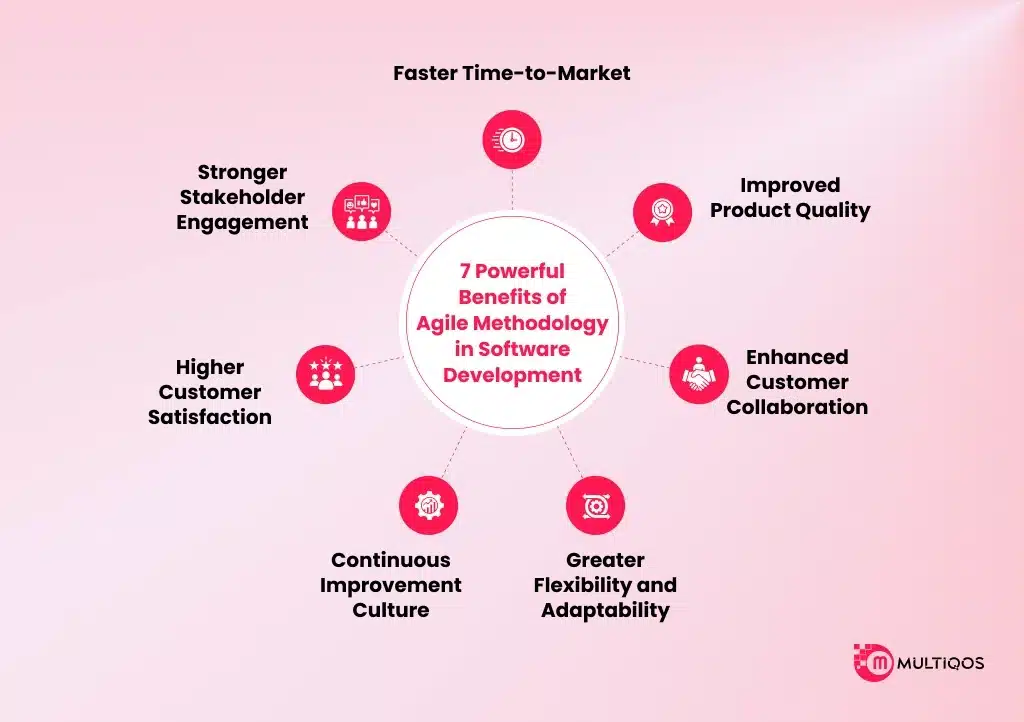Top 7 Benefits of Agile Methodology in Software Development

Summary:
Businesses are constantly seeking ways to innovate faster and deliver high-quality solutions. That’s where the benefits of Agile methodology in software development come into play. This blog takes a closer look at how Agile empowers development teams to respond to change, foster collaboration, and maintain a steady pace of delivery. Whether you’re managing projects, building products, or leading digital transformation, this insightful guide will help you understand why Agile has become the go-to approach for successful software development.
Introduction
These days, if your software isn’t reliable, you’re already behind. Customers expect things to just work, and if they don’t, they’ll move on fast. That’s why teams are moving toward Agile software development as it fits well with how things work now. Markets are evolving at a rapid pace, and with that, user requirements change, and the traditional way of software development isn’t just cutting it anymore.
Agile, on the other hand, makes it easier to adjust on the fly. It’s more flexible. Teams talk more, plan in short bursts, and actually listen to users along the way. That kind of setup means you don’t waste months building something no one wants. You figure things out as you go and make changes without starting over from scratch.
In this blog, we will discuss the top 7 benefits of agile methodology in software development. So, let’s get started!
What is Agile Methodology?
Agile methodology is a software project management method that is both iterative and flexible. Unlike previous models, Agile splits the entire development timeline into incremental parts referred to as sprints. After every sprint, project teams strive to deliver a working product increment that allows them to optimize adjustments during subsequent sprints and further refine the solution.
Agile software development alongside customer participation occurs on a higher level at all stages of development and alongside its execution. Teams collaborate with their defined stakeholders so that the product matures in an appropriate direction. The use of agile tools focuses greatly on empathy and decision making for ratio, thus furthering additional risks, assisting in creating quality during development work accelerating the overall speed of delivery.
7 Powerful Benefits of Agile Methodology in Software Development
In any modern software development company, agile methodology is ubiquitous. A business concentrates on collaboration, agility in operations, and iterative work patterns to improve efficiency and enhance product delivery speed. Whether a startup or an enterprise-level software development company, adopting Agile greatly improves workflow productivity along with customer satisfaction requirements. Let’s explore the key benefits in detail:
1. Faster Time-to-Market
Agile methodology has an incremental nature, it enable teams to build and deliver functional features quickly. Unlike traditional approaches, which take a long time to release the entire product, users can access smaller, usable components at fixed intervals with Agile’s incremental approach. As a result, both the users and businesses can take advantage of their products well beforehand compared to competing substitutes.
2. Improved Product Quality
Every stage of Agile development integrates quality control. Issues are diagnosed and managed to be resolved at the continuous integration, test-driven development, and frequent code review stages. Since testing is performed iteratively in each stage as opposed to a single final phase, critical bugs leaking into the system are bound to be fewer, which improves product stability.
3. Enhanced Customer Collaboration
Just like traditional approaches, where clients engage with the result exclusively at the conclusion, Agile emphasizes continuous cooperation. By using Agile framework, clients are actively engaged during sprint planning, review sessions, and demo meetings. In all phases, they provide feedback. Communication concerning design processes using this form, which meets agile standards, focuses far more on practical needs, leading to less redesign work and greater satisfaction.
4. Greater Flexibility and Adaptability
For Agile software development, continuous feedback is the key part. It simply helps the entire team to quickly adjust to user feedback, company objectives, and market changes. Continuous realignment appraisal, together with iterative development phases, means that for Agile frameworks, making operational changes is quick and doesn’t entail any hefty expenditures.
5. Continuous Improvement Culture
Do you know Agile encourages learning? Yes, you heard it right! Agile not only promotes learning but also growth. After each sprint, the teams make sure to perform reviews and check what challenges the team faced, and how to overcome those next time. This excellent approach not only helps in building better teamwork but also boosts productivity and delivers faster.
6. Higher Customer Satisfaction
Have you ever wondered how Agile improves itself? Agile seeks continuous feedback to enhance the product and deliver faster. Clients really appreciate seeing how their feedback is considered so quickly and how Agile turns that into real results. Being adaptive in this manner greatly enhances confidence and contentment, along with trust, while fostering collaboration.
7. Stronger Stakeholder Engagement
Agile never allows its stakeholders to lag. It always keeps them involved through regular updates, reports, and demos. This active interaction helps build trust and keeps the project aligned with business objectives. There are more chances to support the project, approve the final product, and share helpful feedback if the stakeholders are engaged.
Conclusion
If you’ve reached this far, then you would know that it’s necessary to understand the advantages of Agile methodology in software development in the current business world. Agile enables teams to work smarter, remain productive, and adapt rapidly to change. Agile develops customer trust, controls risk, and increases satisfaction.
If you’re ready to experience these advantages firsthand, it’s time to hire software developers who are well-versed in Agile practices. With the right team and practices in place, managed software provides an efficient way to increase success rates, scale up, or create additional value along with agile methodology adaptation.
FAQs
Agile provides benefits like quicker delivery, better teamwork, improved collaboration, high product standards, and increased adaptability to changes during product development.
As we discussed, Agile is always open to receiving feedback, delivers the product in small parts called sprints, and tests often. This helps improve the product and ensure on-time delivery.
Through divisional sprints and the initial provision of product features, Agile permits optimized work cycles, faster project milestones, as well as ongoing enhancements without requiring the completion of the full product.
Indeed. Agile helps in cutting project expenses by focusing on the major features initially. It enables businesses to adjust their plans and invest based on results and feedback.
Get In Touch







